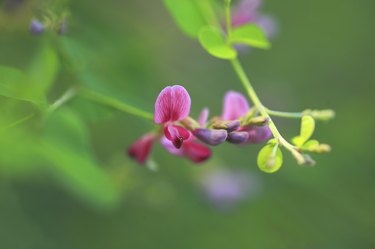
Ridding your lawn of lespedeza (Lespedeza spp.) requires determination and perseverance. These tenacious invaders don't yield to many weedkillers commonly used against other broad-leaf weeds. A combined approach of manual removal and cultural controls provides your first layer of defense and helps lawn grasses stay competitive. If necessary, chemical controls reinforce care and help bring lespedeza invasions to an end.
Types of Lespedeza
Video of the Day
Common lespedeza (Lespedeza striata or Kummerowia striata), also called Japanese clover, pesters home lawns more than any other lespedeza. Its close relative, Korean clover (Lespedeza atpulacea or Kummerowia stipulacea), earns second place. These two invasive annual weeds spread through low-growing, slightly woody stems to overtake weak lawns by late summer. The perennial Chinese bush-clover (Lespedeza cuneata or Sericea lespedeza) troubles lawns and gardens in U.S. Department of Agriculture plant hardiness zones 5 through 11. Originally introduced to the U.S. for erosion control, Chinese bush-clover grows up to 5 feet tall if left unchecked.
Video of the Day
Manual Removal
Annual lespedezas hug the ground too close for mowers to reach them, but hand-pulling these weeds controls small patches effectively. For best results, work in spring before the newly germinated plants get established. Because the annuals reproduce through seeds, hand-pulling before they reach the seed stage brings an end to that yearly cycle. Higher-growing perennial lespedeza has an extensive root system and perennial taproot that makes hand-pulling ineffective; the pieces left behind resprout and multiply. Mowing weakens perennial lespedeza and prevents seeds. The plant is most vulnerable at the flower-bud stage, when its energy reserves hit an annual low.
Cultural Controls
Lespedezas thrive in wet or compacted areas where lawn grasses struggle. Faced with weak opposition, they move in. Encourage strong, healthy lawn grass to keep lespedeza in check. Water deeply and infrequently to promote deep, healthy grass roots, and reduce watering in shaded areas or anywhere lespedeza spreads. Core aerate compacted lawns during their active growing period, when grasses recover and fill in most quickly. For warm-season grasses, aerate in summer. Aerate cool-season grasses in fall. Mow at the recommended height for your lawn type. This gives grass an advantage over competition from lespedeza weeds.
Chemical Remedies
Herbicides that control lespedeza before seedlings appear can only be used by licensed professionals in most states. But once lespedeza emerges, three-way, broad-leaf weed killers containing 2,4D, dicamba, and mecoprop meet the challenge. Application rates must match your grass type or you could damage your lawn. For example, when applied with a hose-end sprayer using 1 gallon of water per 250 square feet, 1 fluid ounce of three-way herbicide per 1 gallon of water is safe for tall fescue (Festuca arundinacea), which grows in USDA zones 4 through 7. St. Augustine grass (Stenotaphrum secundatum), which grows in USDA zone 8 through 10, only withstands 1/2 fluid ounce of herbicide per 1 gallon of water before it is injured.
Safety Precautions
The chemicals effective in treating lespedeza are strong products that require precautions. When working with any of these chemicals, wear gloves, safety goggles, a long-sleeved shirt, long pants, sock and shoes. Avoid all contact with exposed skin, and wash thoroughly with soap and water after handling. Apply through a coarse water spray, to avoid drift onto other nearby plants, and never apply to stressed lawns. Non-grass, garden ornamentals will be harmed by any herbicide spray effective on lespedeza. Apply on a calm, wind-free day when no rain is forecast for 24 hours. Clear the area of people and pets, and keep it clear until the chemical dries completely.
- UGA Extension: Lespedeza Identification and Control in Turfgrass
- Clemson Cooperative Extension: Lespedeza
- NC State University Center for Turfgrass Environmental Research & Education: Lespedeza, Common
- Nebraska Invasive Species Council: Weed Risk Assessment for Lespedeza Cuneata G. Don (Fabaceae) -- Chines Bush-Clover
- Seedland: Climate Maps, Grass Type Chart & More
- Seedland: Grass Names